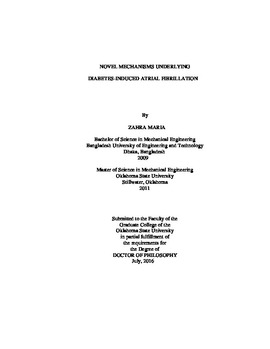| dc.contributor.advisor | Lacombe, Veronique A. | |
| dc.contributor.author | Maria, Zahra | |
| dc.date.accessioned | 2019-08-19T15:38:38Z | |
| dc.date.available | 2019-08-19T15:38:38Z | |
| dc.date.issued | 2016-07-01 | |
| dc.identifier.uri | https://hdl.handle.net/11244/321164 | |
| dc.description.abstract | Diabetes results from a defect in insulin production (type-1) or action (type-2) causing dysfunctional glucose uptake. Diabetic patients are predisposed to cardiac complications such as atrial fibrillation (AF). The heart is a major organ to utilize glucose; however, little is known about atrial glucose metabolism. Glucose transport into the cell via Glucose Transporters (GLUTs) is the rate-limiting step of glucose utilization. Although GLUT4 is the major cardiac isoform, GLUT8 has emerged as a novel isoform. Atrial structural remodeling and advanced glycation end products (AGEs) have been suggested as precursors to AF. However, glucose and insulin disturbances during diabetes may directly affect atrial function, potentially leading to AF. We hypothesize that the dysregulation of glucose metabolism in the diabetic atria underlies diabetes-induced AF. The specific aims of this dissertation are to test the hypothesis that: 1) GLUT-4 and -8 translocation to the atrial cell surface is insulin regulated and is impaired during insulin-dependent diabetes; 2) GLUT-4 and -8 translocation will be impaired during insulin-resistance-induced AF; and 3) impaired glucose metabolism resulting from insulin dysregulation provides a metabolic substrate for the development of AF. GLUT protein expression was measured in atrial myocytes of healthy rats, in the atrial tissue of insulin-deficient (streptozotocin-induced) and insulin-resistant (high-fat-diet-induced) mice. Active cell surface GLUT content was measured using the biotinylated photolabeled assay in the perfused heart. AF was induced by transesophageal atrial pacing. Atrial fibrosis and AGE were measured using histological analysis. We reported that both GLUT4 and GLUT8 are insulin sensitive in the healthy atria and are regulated by the insulin signaling pathway (i.e., Akt/AS160). Our data demonstrated that GLUT translocation is downregulated in the atria during insulin dysregulation. In addition, insulin treatment rescued GLUT translocation to the atrial cell surface during insulin deficiency but not during insulin resistance. We reported the absence of atrial fibrosis and AGE accumulation in animals with insulin dysregulation. Our results also indicated that insulin dysregulation significantly increases the vulnerability to AF. Overall, the results suggest that in the absence of atrial structural remodeling, insulin dysregulation may induce perturbations in energy production which could underlie the development of diabetes-induced AF. | |
| dc.format | application/pdf | |
| dc.language | en_US | |
| dc.rights | Copyright is held by the author who has granted the Oklahoma State University Library the non-exclusive right to share this material in its institutional repository. Contact Digital Library Services at lib-dls@okstate.edu or 405-744-9161 for the permission policy on the use, reproduction or distribution of this material. | |
| dc.title | Novel Mechanisms Underlying Diabetes-Induced Atrial Fibrillation | |
| dc.contributor.committeeMember | Kalkan, A. Kaan | |
| dc.contributor.committeeMember | Santhanakrishnan, Arvind | |
| dc.contributor.committeeMember | Lloyd, Pamela G. | |
| osu.filename | Maria_okstate_0664D_14821.pdf | |
| osu.accesstype | Open Access | |
| dc.description.department | Mechanical and Aerospace Engineering | |
| dc.type.genre | Dissertation | |
| dc.type.material | Text | |
